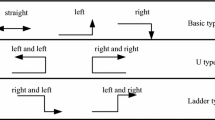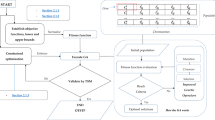Abstract
In view of the disturbance of the emergency signal preemption to the normal traffic flow, a scientific and reasonable signal transition optimization model was proposed in this paper, in which fair and efficiency are both considered. Since the emergency signal preemption may lead to longer vehicle queuing and greater vehicle delay at intersections, the difference of queue length and the vehicle delay were selected as the objectives taking into account the fair benefit, and a multi-objective signal recovery transition optimization model for emergency rescue was established based on the power function method. The queue length was calculated by the 95% queue length model of the SYNCHRO, and the average vehicle delay was calculated with HCM2000 delay model; furthermore, parameters’ weight in the model was calibrated with the variation coefficient method, and model was solved by genetic algorithm. Moreover, power function method was used to score the signal recovery transition schemes of emergency traffic. Finally, based on the survey data from the typical route network in the Lion Mountain area of Suzhou City, the model proposed in this study was compared with three classical smooth transition schemes (immediate transition scheme, two-cycle transition scheme and three-cycle transition scheme) at the scenario of evening peak. Simulation results showed that the model in this paper can reduce the vehicle delay and queue length compared with the above three smooth transition schemes; the average reduction ratio of queue length delay was 13.82%, and this number of queue length was 13.65%, from which we can conclude that the model proposed in this has better performance than other three classical transition schemes in emergency signal transition applicability.





Similar content being viewed by others
References
Xiao F, Wang Z, Ye N, Wang R, Li X-Y (2018) One more tag enables fine-grained RFID localization and tracking. IEEE/ACM Trans Netw 26(1):161–174
Xiao F, Chen L, Sha C, Sun L, Wang R, Liu AX, Ahmed F (2018) Noise tolerant localization for sensor networks. IEEE/ACM Trans Netw 26(4):1586–1599. https://doi.org/10.1109/TNET.2018.2852754
Lee J, Shin B (2017) SensDeploy: efficient sensor deployment strategy for real-time localization. Hum Centric Comput Inf Sci. https://doi.org/10.1186/s13673-017-0117-2
Yun I, Park BB, Lee CK et al (2012) Comparison of emergency vehicle preemption methods using a hardware-in-the-loop simulation. KSCE J Civ Eng 16(6):1057–1063
Nelson E, Bullock D (2000) Impact of emergency vehicle preemption on signalized corridor operation: an evaluation. Transp Res Rec J Transp Res Board 2000(1727):1–11
Yun I, Best M (2008) Evaluation of transition methods of the 170E and 2070 ATC traffic controllers after emergency vehicle preemption. J Transp Eng 134(10):423–431
Hall T, Box PO, Best M (2007) Evaluation of emergency vehicle preemption strategies on a coordinated actuated signal system using hardware-in-the-loop simulation. In: Transportation Research Board 86th Annual Meeting
Nan T (2013) Signal recovery strategy after the passage of emergency vehicles at single intersection. In: 8th China Intell Transp Annual Meeting
Chen W, Liu Y (2017) Gap-based automated vehicular speed guidance towards eco-driving at an unsignalized intersection. Transportmetr B. https://doi.org/10.1080/21680566.2017.1365661
Chen W, Liu Y, Yang X, Bai Y, Gao Y, Li P (2015) Platoon-based speed control algorithm for ecodriving at signalized intersection. Transp Res Rec J Transp Res Board 2489(1):29–38
Shelby S, Bullock D, Gettman D (2006) Transition methods in traffic signal control. Transp Res Rec J Transp Res Board 1978(1):130–140
Shu A, Zhang L, Xu L, Lu C (2015) transition adjustment tactic of signal coordinated control scheme for urban traffic arterial. Traffic Inf Secur 33(1):122–126
Guo H, Peng Q (2014) A novel method for fast smoothing transition of arterial coordination control plans. J Southwest Jiaotong Univ 49(5):882–887
Lu K, Xu J, Zheng S, Li L (2011) Development and evaluation of a constrained optimization model for traffic signal plan transition. Transp Res Part C 20(1):185–198
Obenberger JT, Collura J (2007) Methodology to assess traffic signal transition strategies for exit preemption control. Transp Res Rec J Transp Res Board 2035(12):158–168
Lu Kai X, Jianmin ZS, Lin LI et al (2012) Optimization algorithm of coordinated control scheme transition of traffic signal. J Traffic Transp Eng 12(6):97–103
Darani ZS, Kaedi M (2017) Improving the interactive genetic algorithm for customer-centric product design by automatically scoring the unfavorable designs. Human Centric Comput Inf Sci 7(1):38. https://doi.org/10.1186/s13673-017-0119-0
Khoobjou E, Mazinan AH (2017) On hybrid intelligence-based control approach with its application to flexible robot system. Human Centric Comput Inf Sci 7:5. https://doi.org/10.1186/s13673-017-0086-5
Sabharwal S, Aggarwal M (2017) Test set generation for pairwise testing using genetic algorithms. J Inf Process Syst 13(5):1089–1102
Kaur J, Kaur K (2017) A fuzzy approach for an IoT-based automated employee performance appraisal. Comput Mater Contin 53(1):23–36
Benziane SH, Benyettou A (2017) Dorsal hand vein identification based on binary particle swarm optimization. J Inf Process Syst 13(2):268–283
Wang J, Cao Y, Li B, Kim HJ, Lee S (2017) Particle swarm optimization based clustering algorithm with mobile sink for WSNs. Future Gener Comput Syst 76:452–457
Kumar Y, Sahoo G (2017) An improved cat swarm optimization algorithm based on opposition-based learning and Cauchy operator for clustering. J Inf Process Syst 13(4):1000–1013
Wang J, Cao J, Sherratt RS, Park JH (2017) An improved ant colony optimization based approach with mobile sink for wireless sensor networks. J Supercomput 8:1–13. https://doi.org/10.1007/s11227-017-2115-6
Wang J, Cao Y, Li B, Lee S, Sherratt RS (2015) Bio-inspired ant colony optimization based clustering algorithm with mobile sinks for applications in consumer home automation networks. IEEE Trans Consum Electron 61(4):438–444
Zheng Y, Jeon B, Sun L, Zhang J, Zhang H (2017) Student’s t-hidden Markov model for unsupervised learning using localized feature selection. IEEE Trans Circuits Syst Video Technol. https://doi.org/10.1109/TCSVT.2017.2724940
Zheng Y, Sun L, Wang S, Ning J (2018) Spatially regularized structural support vector machine for robust visual tracking. IEEE Trans Neural Netw Learn Syst. https://doi.org/10.1109/TNNLS.2018.2855686
Jayaprakash G, Muthuraj MP (2018) Prediction of compressive strength of various SCC mixes using relevance vector machine. Comput Mater Contin 54(1):83–102
Xu M, Ye Z, Sun H, Wang W (2016) optimization model for transit signal priority under conflicting priority requests. Transp Res Rec J Transp Res Board 2539(1):140–148
Chen Q, Yan K (2005) Research on signal timing for urban intersections with genetic algorithms optimizing with the idea of bus priority. Syst Eng Theory Pract 25(11):133–138
Li Q, Hou F (2017) Gray combined forecasting model for road traffic accidents based on coefficient of variation method. Saf Environ Eng 24(6):130–133
Sun C, Xu J (2009) Study on traffic signal timing optimization for single point intersection based on synchro software system. J Highw Transp Res Dev 26(11):117–122
Ma J, Xing L, Dai X, America Transportation Research Board TRB (2007) Highway capacity manual. China Communications Press, Beijing
Jiping Ma, Lei X, Xuezhen D et al (2015) Multi-object optimization model for bus station network planning. J Highw Transp Res Dev 32(9):128–132
Funding
This study was funded by MOE (Ministry of Education in China) Project of Humanities and Social Sciences (17YJCZH225) ” Emergency oriented multi-objective traffic management and control model at urban area in the environment of big data”. It was also funded by the humanistic and social science climbing program funding of University of Shanghai for Science and Technology (SK18PB03), and by the humanistic and social science research funding of University of Shanghai for Science and Technology (SK17YB05). Prof. Jin Wan g is the corresponding author.
Author information
Authors and Affiliations
Corresponding author
Ethics declarations
Conflict of interest
Jiao Yao and Jin Wang declare no conflict of interest. Kaimin Zhang and Yaxuan Dai declare no conflict of interest.
Ethical approval
This article does not contain any studies with human participants or animals performed by any of the authors.
Informed consent
Informed consent was obtained from all individual participants included in the study.
Rights and permissions
About this article
Cite this article
Yao, J., Zhang, K., Dai, Y. et al. Power function-based signal recovery transition optimization model of emergency traffic. J Supercomput 74, 7003–7023 (2018). https://doi.org/10.1007/s11227-018-2596-y
Published:
Issue Date:
DOI: https://doi.org/10.1007/s11227-018-2596-y




